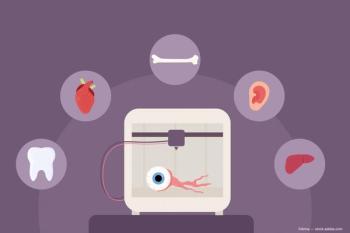
- Ophthalmology Times, March 15 2019
- Volume 44
- Issue 5
CAIRS may eliminate complications from synthetic ring segments
Novel technique could help surgeons treating keratoconus, ectasia
Reviewed by Soosan Jacob, MS, FRCS, DNB
A novel technique to
Dr. Jacob developed the technique because the use of synthetic ring segments often has led to complications such as extrusion, migration, melt, corneal necrosis, and even infections necessitating corneal transplantation, she said. She wanted to find a way to decrease the incidence of these complications.
In the study, which was published in the Journal of Refractive Surgery,1 CAIRS trephined from donor cornea were then implanted into femtosecond laser-dissected channels in the cornea in 24 eyes (20 patients) with keratoconus. The CAIRS were used in the 6.5-mm optic zone. Dr. Jacob initially used ring segments (Intacs, Addition Technology) not as an implant but as an instrument to help get the CAIRS in, but later she found that the CAIRS pushed right in.
Afterward,
Making the choice
The choice was made depending on each patient’s minimum corneal thickness. With contact lens-assisted CXL, a riboflavin-soaked bandage contact lens is placed on the eye to help increase the corneal thickness. The contact lens used is ultraviolet barrier-free.
The results in patients having accelerated
There also were significant improvements in spherical equivalent, simulated maximum keratometry, steepest keratometry, topographic astigmatism, anterior and posterior best fit spheres, mean power in the 3- and 5-mm zones, as well as other areas. No eye had any progression during the follow-up, which ranged from 6 to 18 months. All segments remained in position, and no segment-induced complications occurred.
“There is basically no disadvantage [with CAIRS],” Dr. Jacob said. “It’s biocompatible, easily available, effective, stable, safe, reversible, and adjustable.”
She looks forward to the creation of nomograms for CAIRS, femtosecond-cut CAIRS, eye bank-prepared segments, modified segments, and increased storage abilities.
Disclosures:
Soosan Jacob, MS, FRCS
E: [email protected]
This article was adapted from Dr. Jacob’s presentation at Refractive Surgery Subspecialty Day at the 2018 meeting of the American Academy of Ophthalmology. Dr. Jacob has a patent pending for shaped corneal segments and the devices and processes used to manufacture them.
References:
1. Jacob S, et al. Corneal Allogenic Intrastromal Ring Segments (CAIRS) combined with corneal crosslinking for keratoconus. J Refract Surg. 2018; 34:296–303.
Articles in this issue
over 6 years ago
Valuing power of the lenticleover 6 years ago
Study: RLE, monovision LASIK results similar in 45-60 age groupover 6 years ago
Making the most of diagnostic technology toolkitalmost 7 years ago
Optical sector must embrace the telemedicine waveNewsletter
Don’t miss out—get Ophthalmology Times updates on the latest clinical advancements and expert interviews, straight to your inbox.













































.png)


